8 LIGHTNING STRIKES TWICE
THE RELEASE OF VIRTUAL XI, 1997–1998
“We’re not cool. There’s other new things going on. The only time we were trendy was in ’83, ’84. We’re not cool ’cos we’ve been around so long, but I’m proud of Virtual XI.”
—Steve Harris,
quoted in Kerrang!, 1998
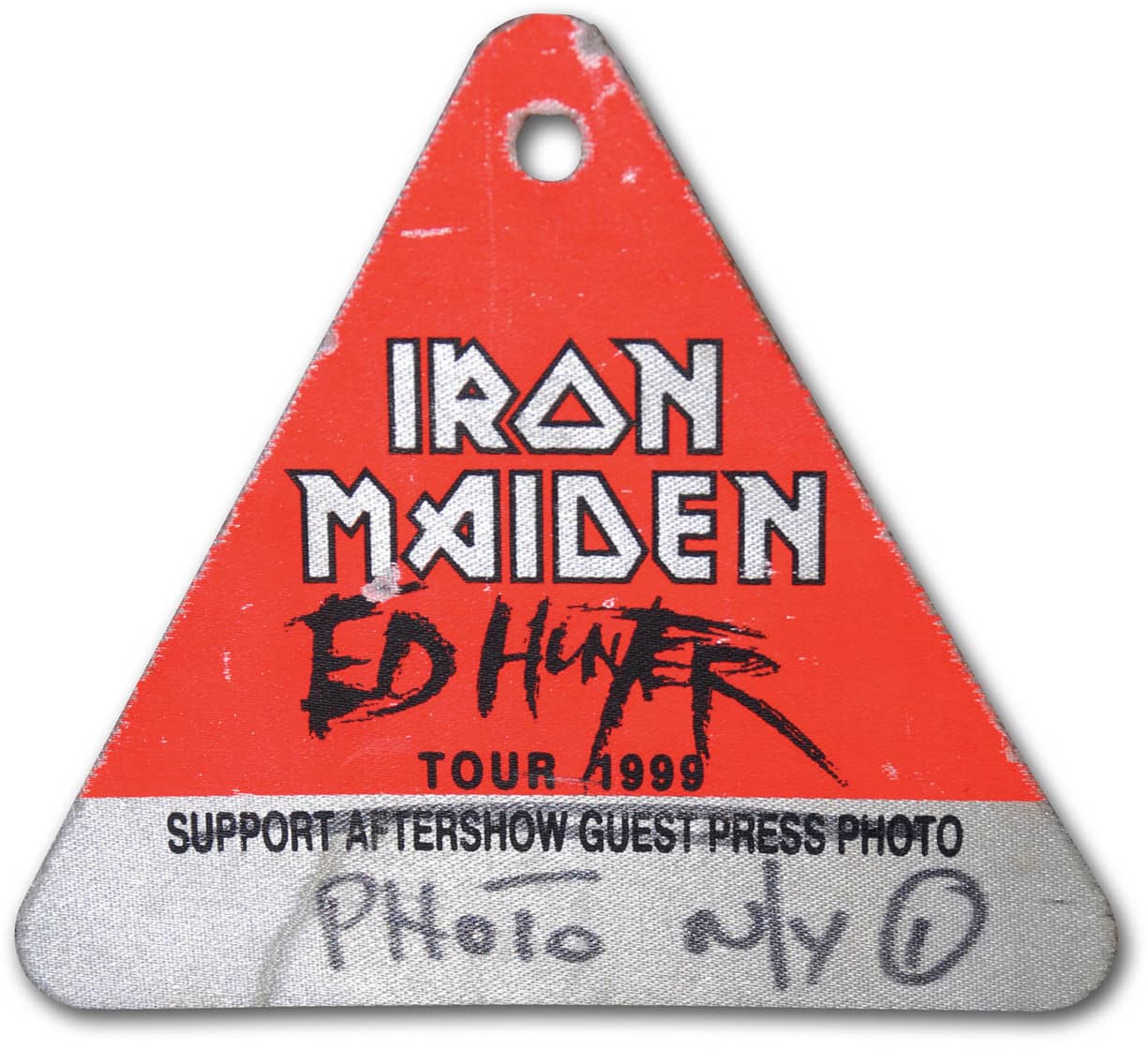
Iron Maiden entered Barnyard Studios in Essex with Nigel Green sometime in 1997 to begin work on their second album with Blaze Bayley. The new Maiden frontman had acquired nothing but respect for Steve Harris.
“It’s difficult to describe someone you work so close with because he’s a friend really,” Bayley told Kerrang! in 1998. “But it’s been a real thrill for me to work and write songs with Steve. He’s one of those people that doesn’t give up easily, whether his music or on the football field. In my previous band I was forced to make so many compromises and I see now how naive I was. With Iron Maiden, we’re fighting exactly the same battles but Steve has the courage to say, ‘No, fuck you, I’m not doing it.’”
Released in March 1998, Virtual XI included extensive keyboards handled not by the band’s usual session player, Michael Kenney, but rather by Harris. The album also featured significantly less songwriting input from Janick Gers than other releases from his previous seven years in the band. Virtual XI is also notable for some significantly long songs, namely, the “The Angel and the Gambler” (nine and a half minutes), “The Clansman,” (eight and a half minutes), and “Don’t Look to the Eyes of a Stranger” (eight minutes).
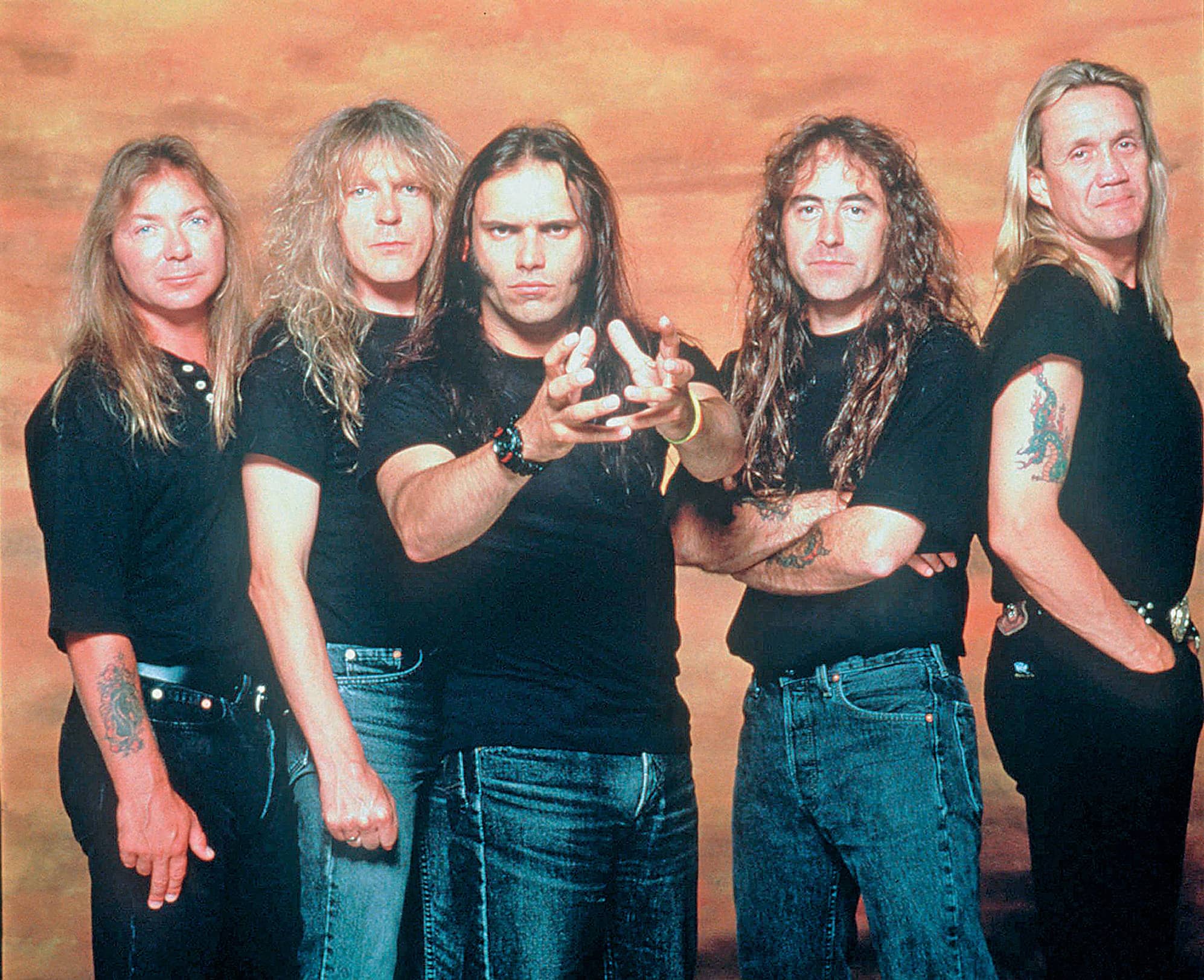
The keen observer realized that Blaze Bayley was not especially well-appreciated by Maiden loyalists. On the other hand, perhaps fans and critics were too loyal to Dickinson. Did they give Bayley a proper chance? AP Photo/Archiv
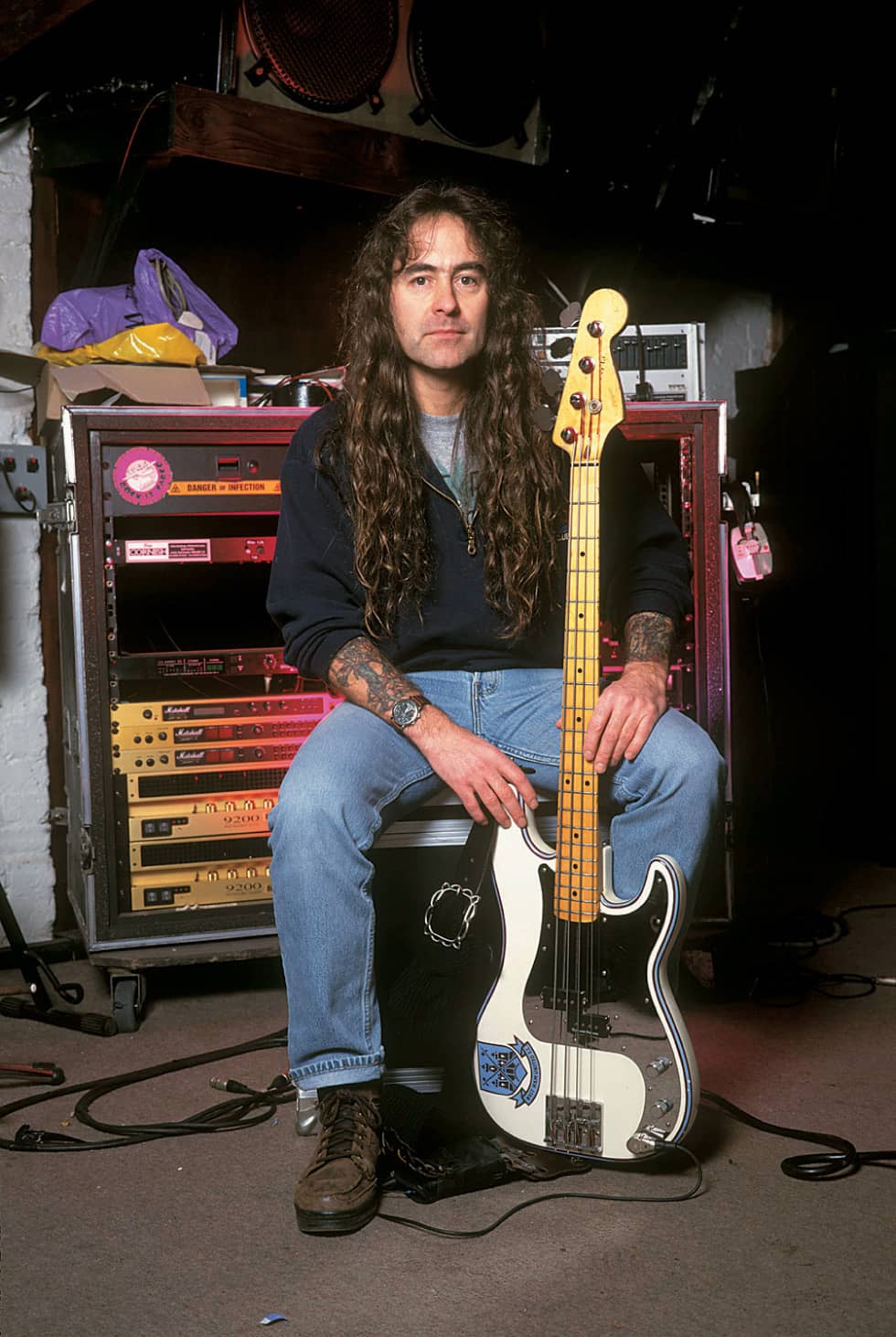
Barnyard Studios, Essex, England. All Mick Hutson/Redferns/Getty Images
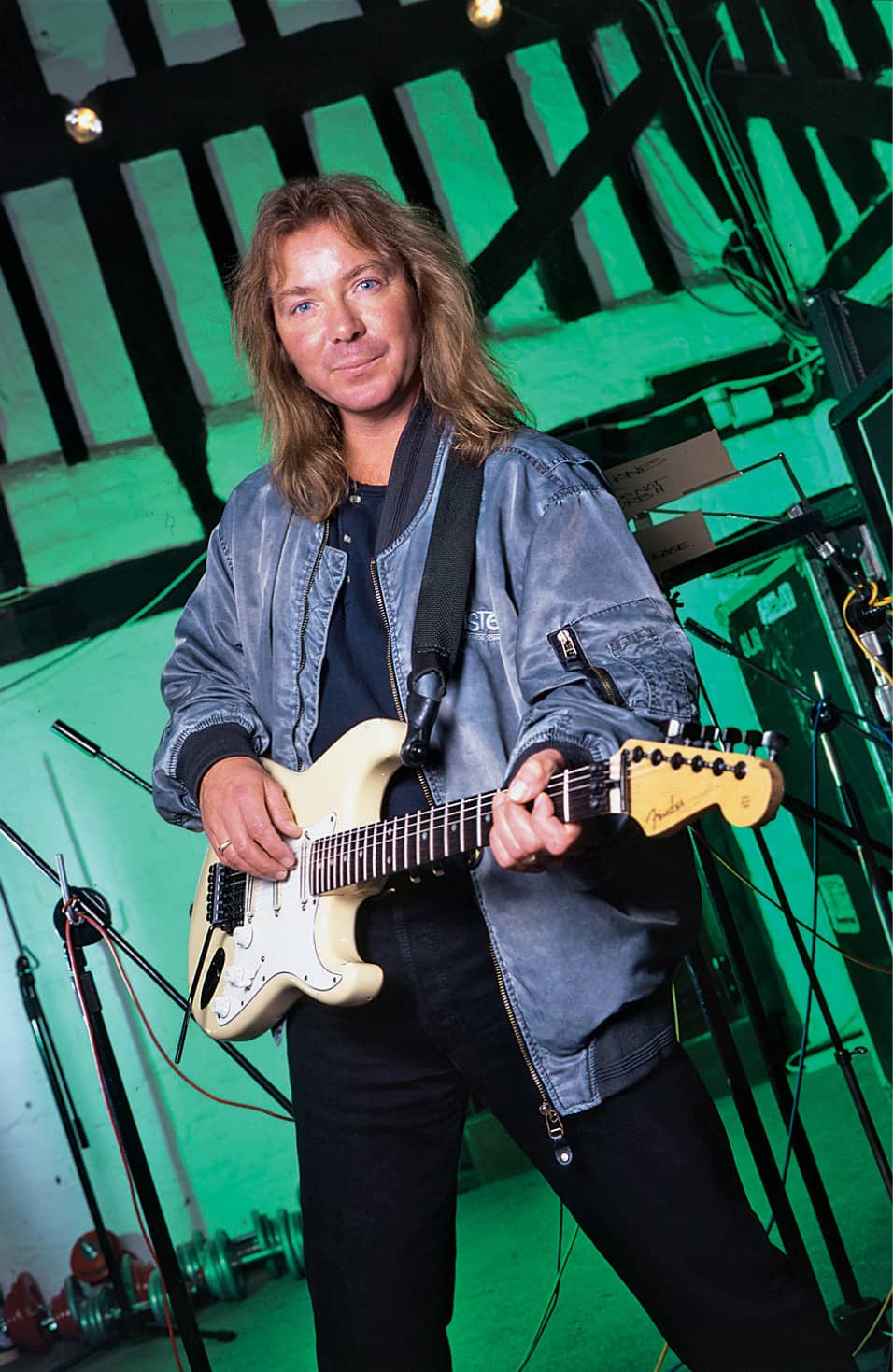
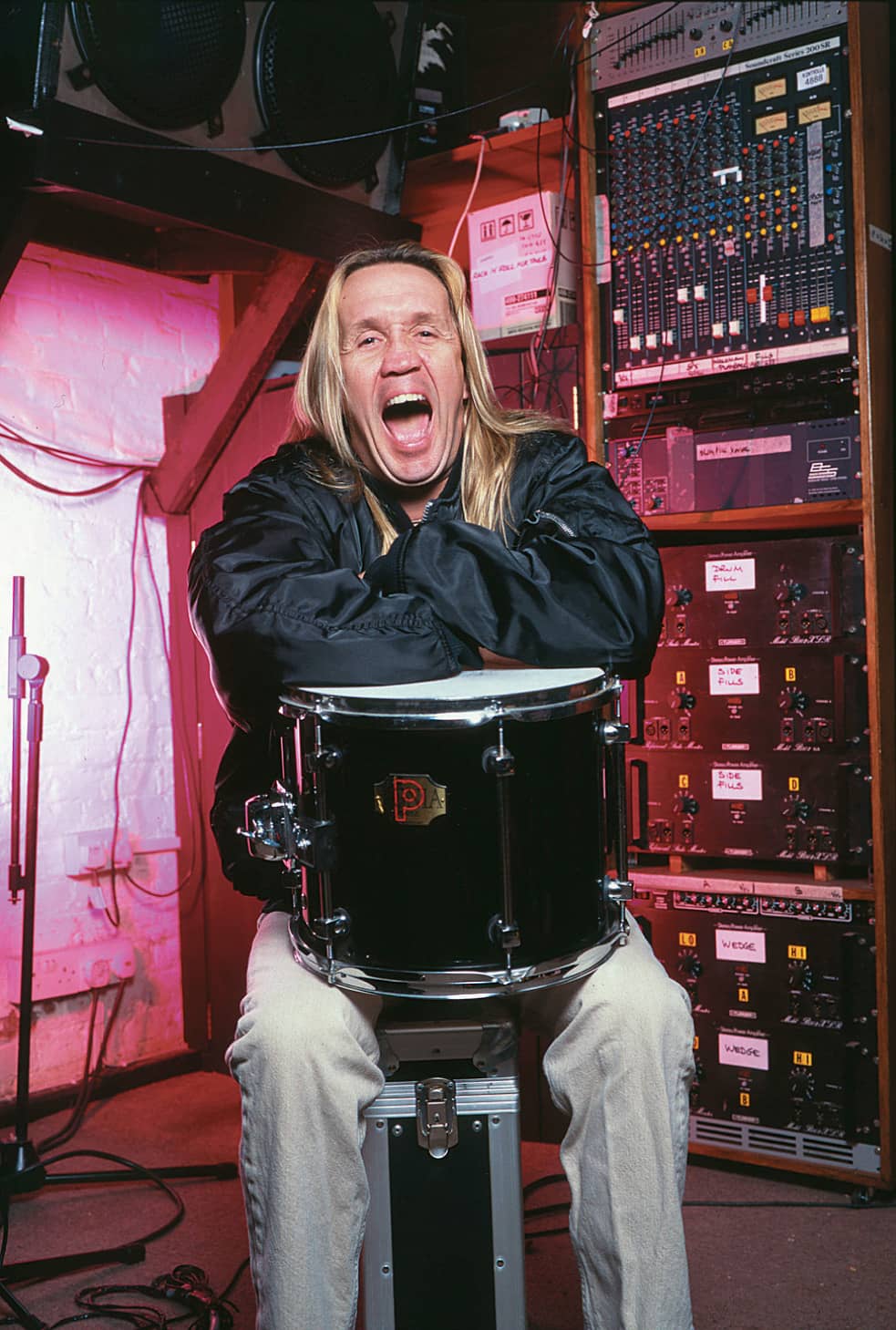
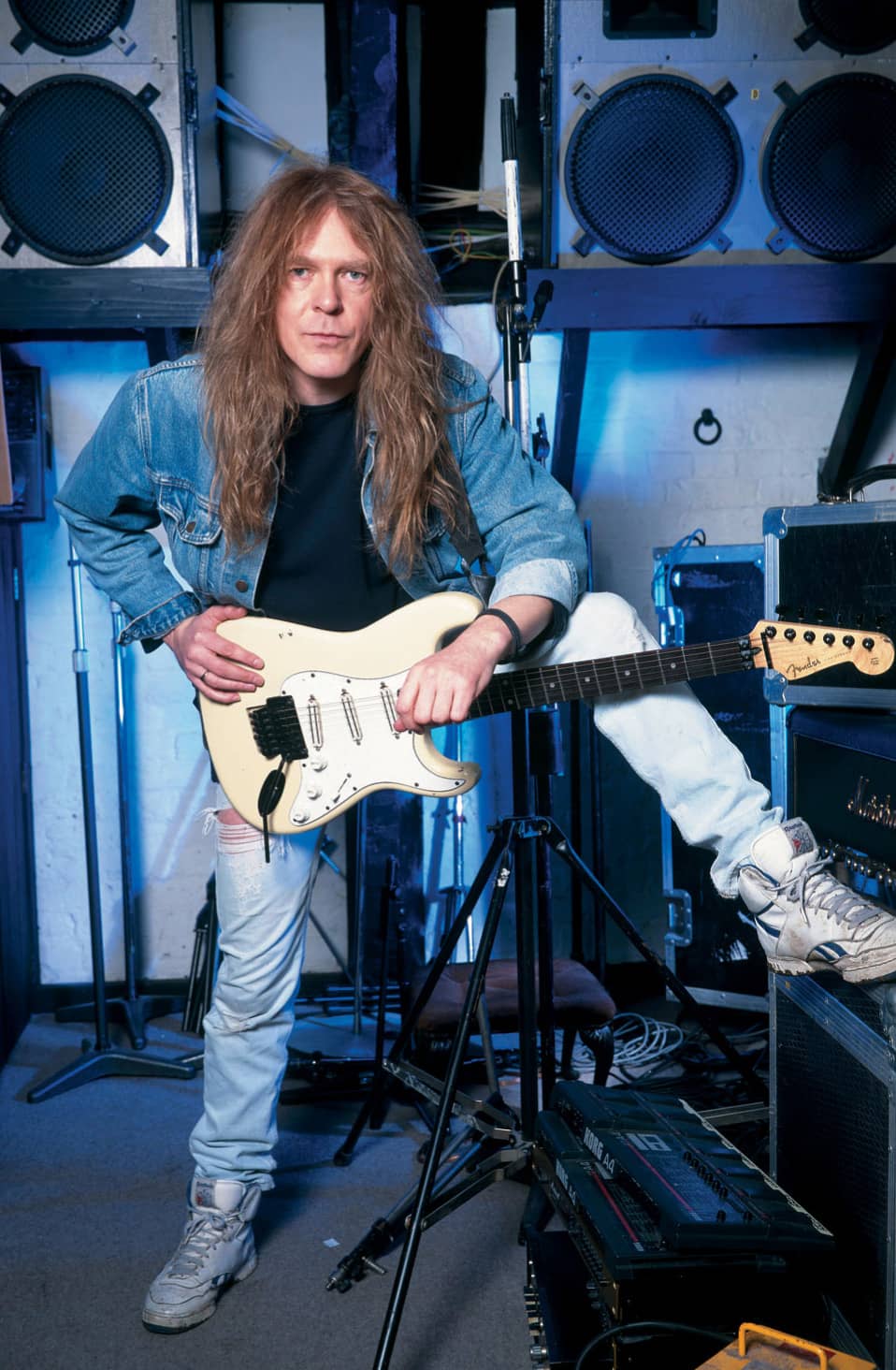
“We didn’t approach this record any differently than we’ve always done,” Harris explained when interviewed by Bob Nalbandian of hardradio.com. “We just went in and recorded it and we just wrote whatever felt right during that particular time. ‘The Angel and the Gambler’ is actually a good example because when I came up with that song idea, I put it on a mini tape recorder while I was driving down the motorway, and I distinctly remember saying to myself … ‘this reminds me of the Who meets UFO.’ So I just took it in that direction.”
The album was something of a minor disaster. Initial sales indicated that Virtual XI was the poorest selling album in Maiden history, shifting less than one million units worldwide. The reviews were not exactly overwhelming, either. Perhaps, after all, the band had made the wrong decision hiring Bayley. It’s certainly true to the keen observer that he was not especially well-liked by Maiden loyalists. On the other hand, perhaps fans and critics were too loyal to Dickinson. Had Maiden fans given Bayley a proper chance? Were they too harsh?
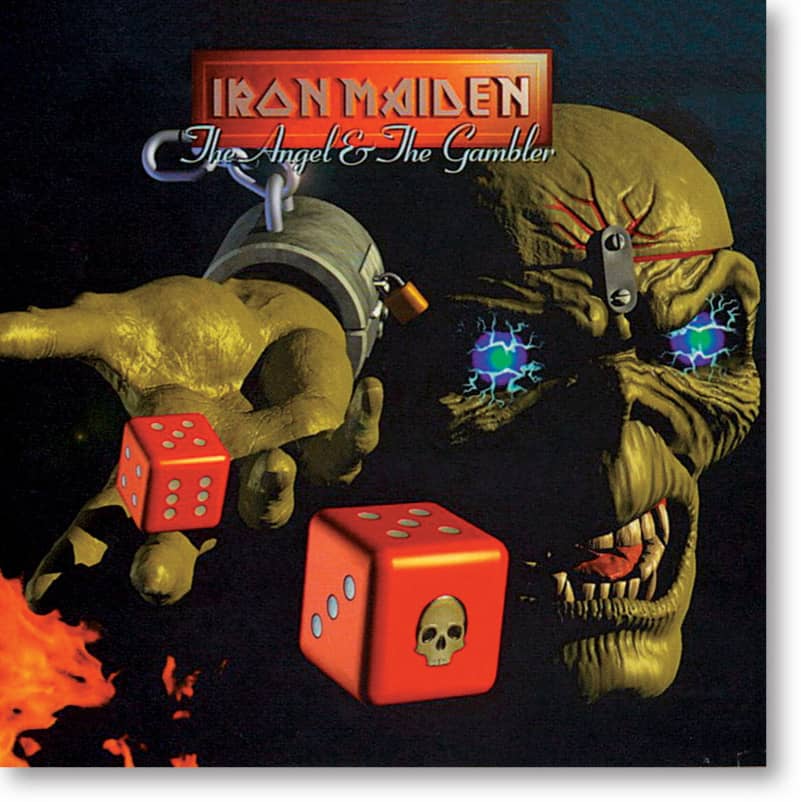
“The Angel and the Gambler” (March 1998).
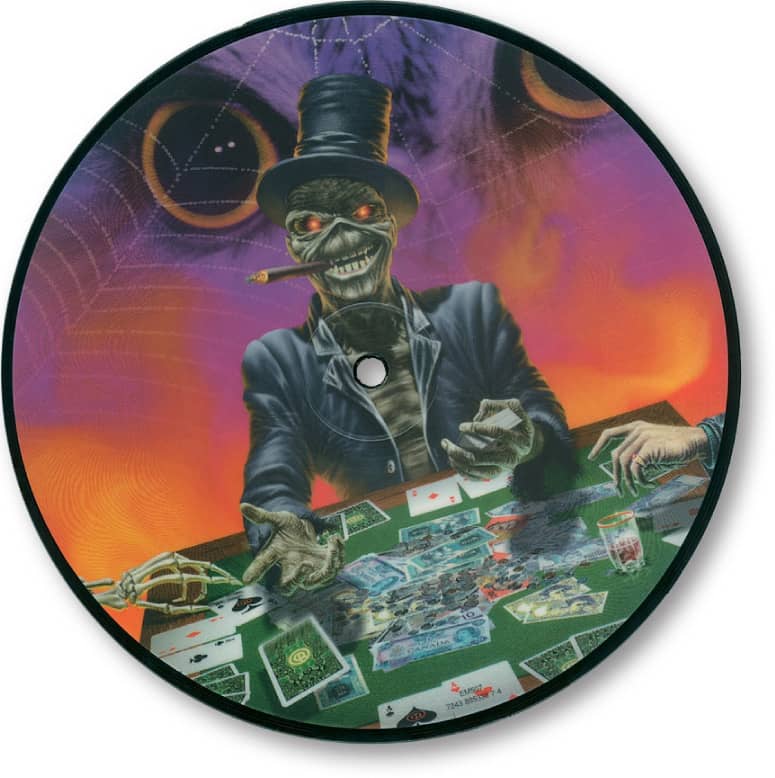
“The Angel and the Gambler” picture disc.
“It’s almost like we’d get worried if we got a good review!” Harris explained in Kerrang!. “My daughter’s homework reports are better than our reviews. I suppose at times you feel like you’re up against everything. Every time we do an album we have to prove ourselves again. But in a weird way that works for you, because you fight even harder to show people you can still cut it. It gives you an edge. It’s funny. You don’t tend to remember the good reviews, but the bad ones you do. It’s the bad ones that fire you up and make you think, ‘Fuck them, we’ll show ’em.’ It gives you a bit of an attitude again. It’s a challenge.”
Despite any motivation provided by two poorly received albums, slipping sales raised all sorts of sordid questions. Had fans moved on to other bands? Should Maiden be left in the past like an historical relic?
“We’re not cool,” Steve Harris admitted to Kerrang!. “There’s other new things going on. The only time we were trendy was in ’83, ’84. We’re not cool ’cos we’ve been around so long, but I’m proud of [Virtual XI]. There’s no compromise, as usual. We still do what we do. I’m proud of that.”
Perhaps the poor sales were due to the fact that metal was no longer in vogue in some parts of the world, particularly in America, where the success of Nirvana earlier in the decade had prompted a major-label bonanza for alt- and indie-rock acts. “In Europe [heavy metal is] still very popular,” Murray told Gary James in 1999 (harbinger.org). “It’s thriving. We’ve been made to understand in America it’s really dropped off. There are still rock fans out there, but not as many as there were ten years ago.”
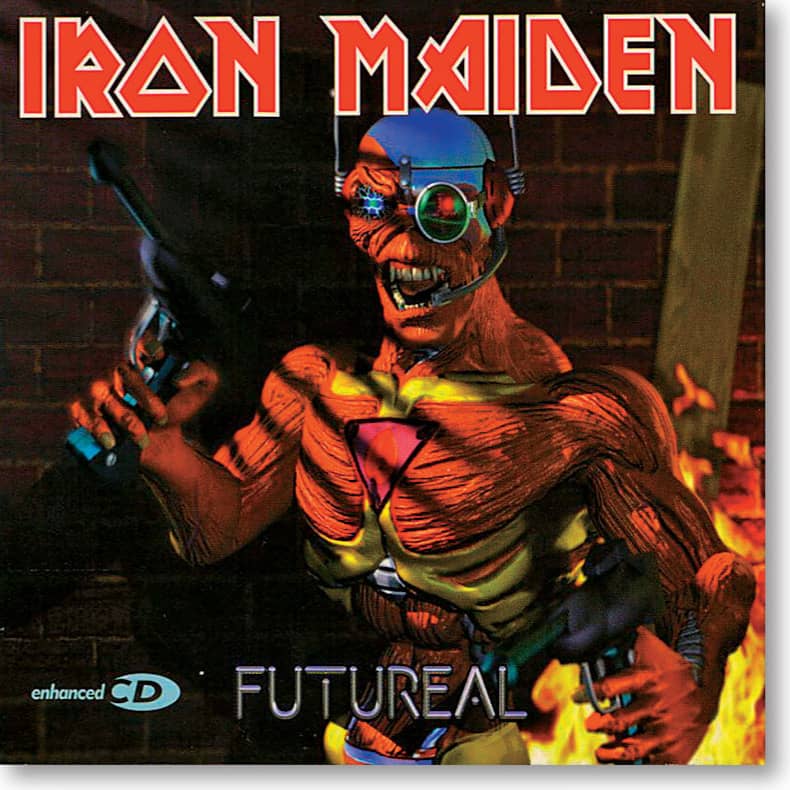
“Futureal” (July 1998) enhanced CD and 7-inch single. The former featured the video for “The Angel and the Gambler.”
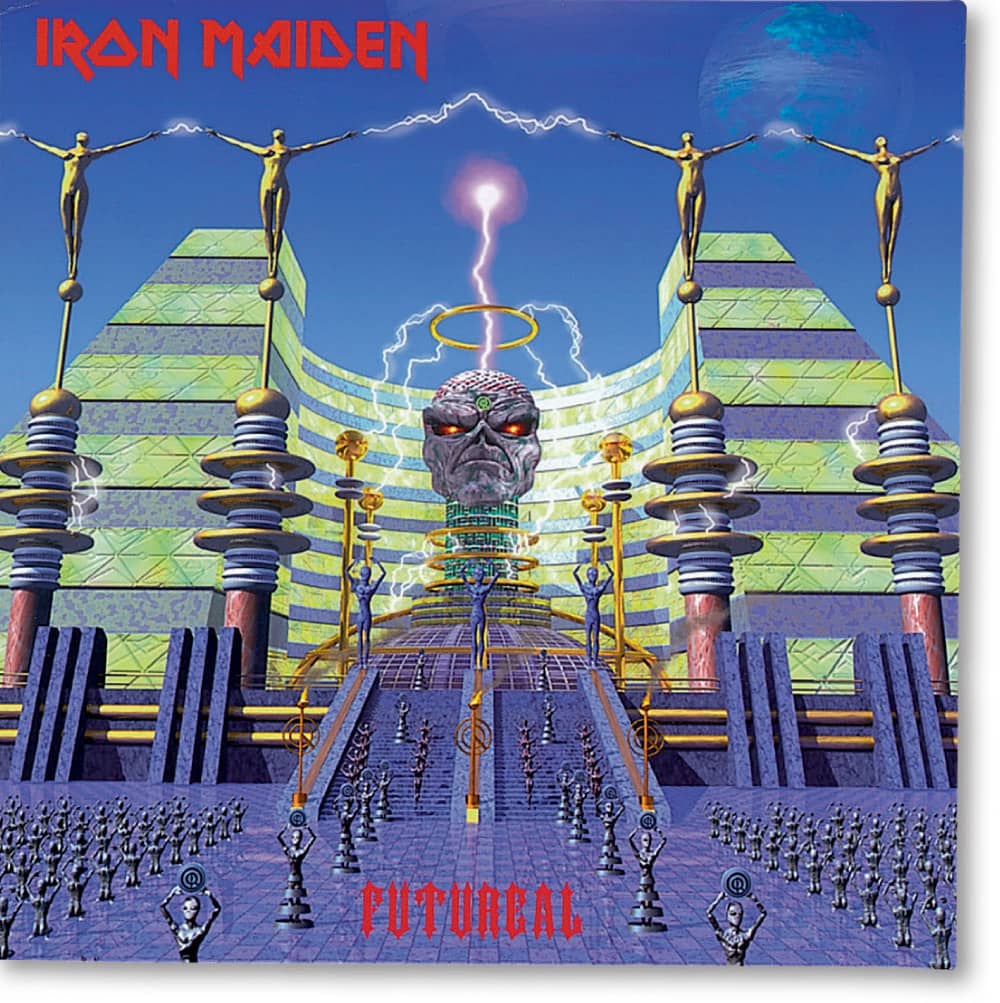
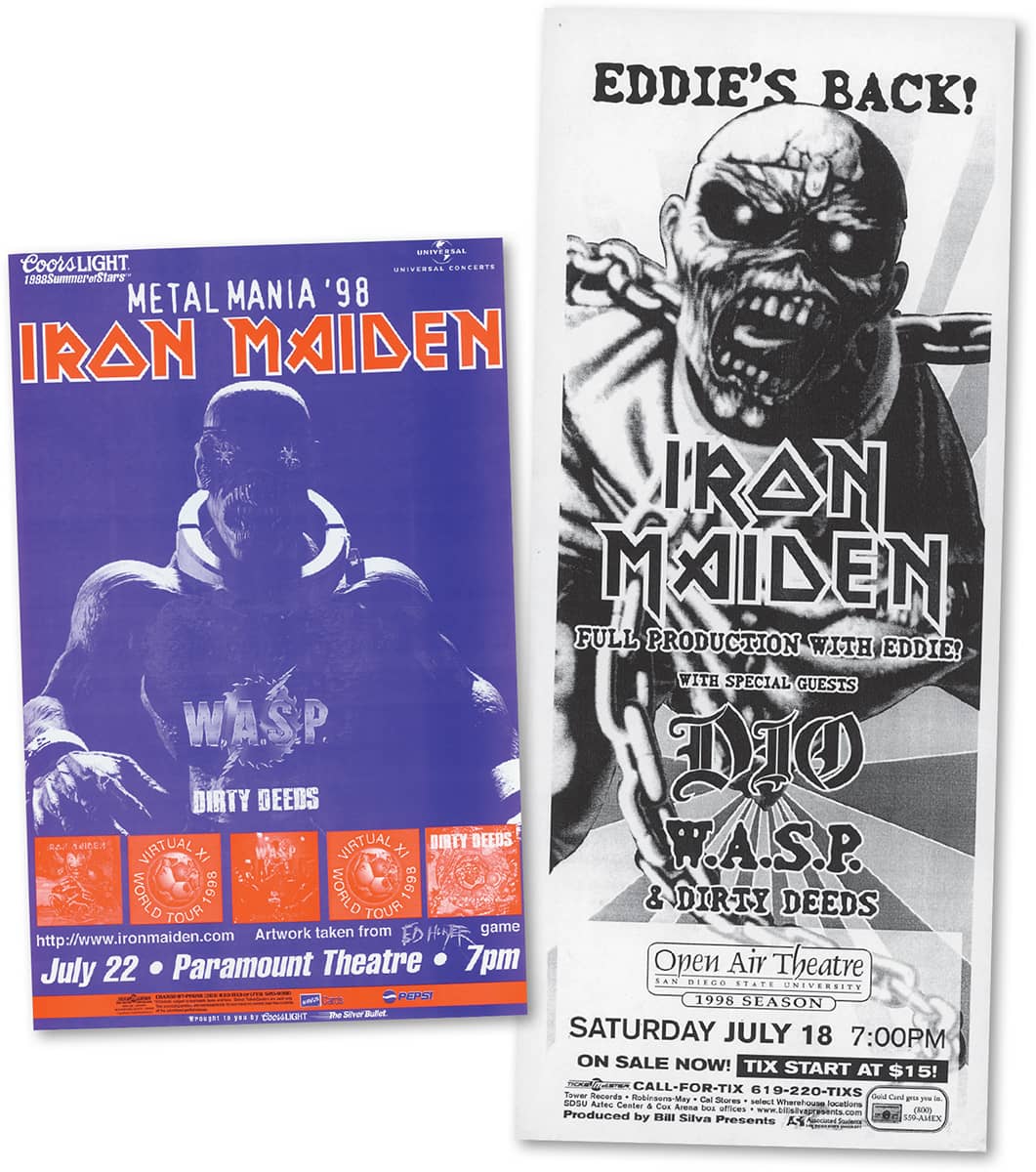
On the U.S. leg of the Virtual XI tour, Bayley had to face up to boos and heckles, and as with The X Factour, half of the North American leg had to be cancelled when the singer suffered allergic reactions to stage props. The July 18 San Diego date advertised here was played on August 3. Denver (July 22) wasn’t rescheduled.
To please the hardcore Maiden enthusiasts and to attract new fans, Harris assisted in the re-release and remastering of the complete Maiden discography up to 1993’s Live at Donington. It was time for another tour so the band hit the road again.
“The X Factor sold about a million copies worldwide and Virtual XI is pretty much there too,” Murray said (scritube.co.uk). “That’s still justification to go and tour. Obviously, the mid-’80s were the pinnacle for the band. It’s like a wave—it goes up and down and you have to go with the flow. If we sold twenty albums, we’d have to reevaluate, but as far as the album sales go, we can fully justify playing. As long as the fans come to the show, we’ll still be there.”
And play they did. The Virtual XI world tour kicked off with a secret concert at The Oval P.H. (that’s “public house,” or bar, for the uninitiated) in Norwich, England, on April 22, 1998, and finished with a performance at the Monsters of Rock festival in Buenos Aires, Argentina, on December 12 of the same year.
As with the previous tour, the band played much smaller venues than they had with Bruce Dickinson, and ticket sales were certainly not as brisk as they were on past tours. Then there also were some parts of the world that Maiden could not play for economic reasons, such as Australia and New Zealand.
“The logistics to get the equipment over there are very expensive,” Murray explained in 1998 (scritube.co.uk). “We haven’t played over there for years. It seems like the market there is not very receptive for the band at this time. To go there for playing small clubs is not worth it. If the market moves, we’ll go there.”
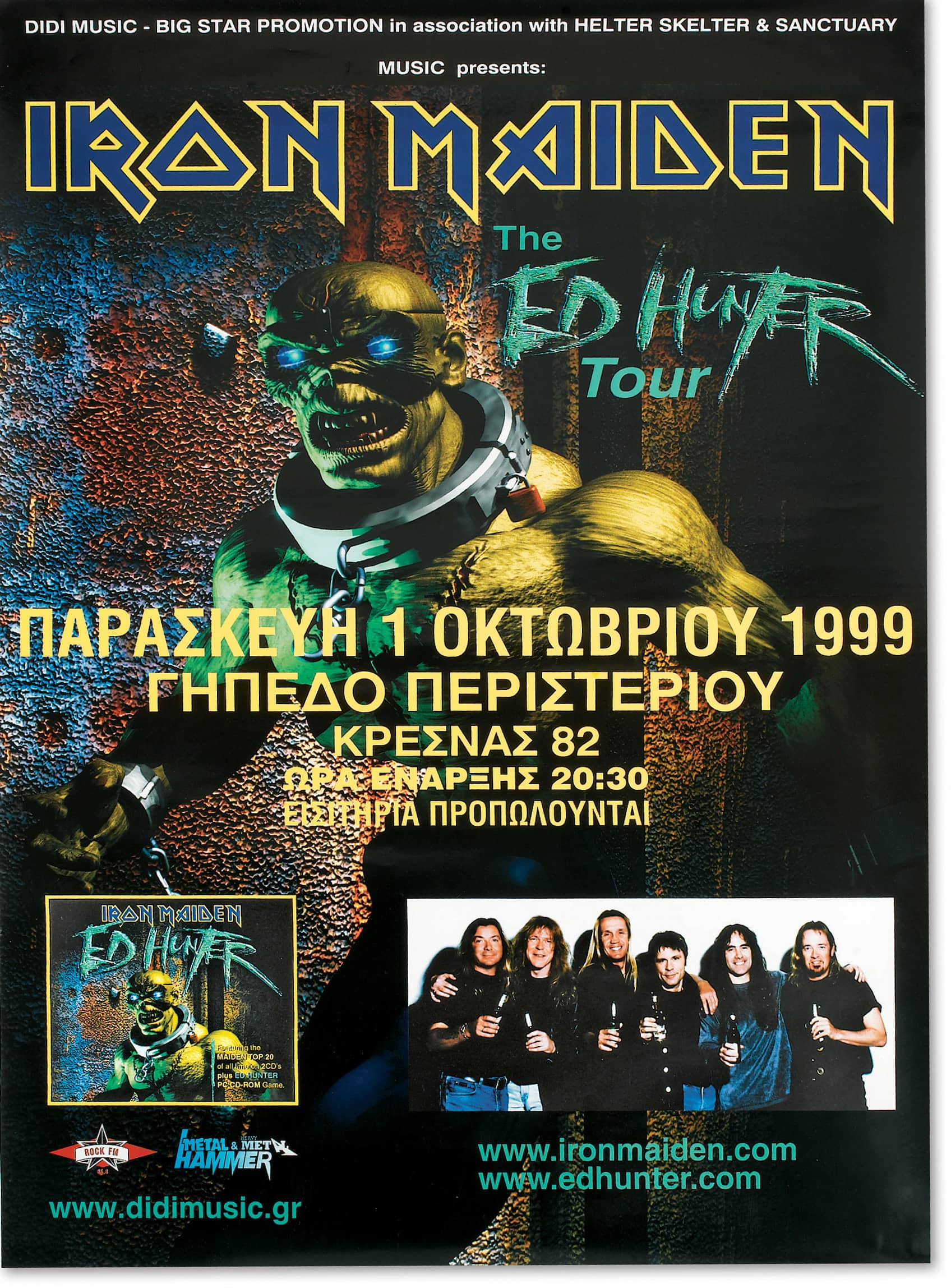
Ed Hunter tour, Athens, October 1, 1999.
In the United States, Iron Maiden still struggled to sell their fans on the idea of a new frontman. Bayley had to face up to boos and heckles, and as with The X Factour, half of the North American leg had to be cancelled because Bayley suffered allergic reactions to some stage props.
In February 1999, perhaps inevitably, Bayley announced his departure from the band. “Not the right singer for Iron Maiden at all. Not in the slightest. But his solo stuff is great,” opined Paul Di’Anno years later in an interview with Marko Syri. “I think Iron Maiden was a very good experience for him to experience the machine. There is a lot of bullshit that goes on in Iron Maiden.”
Looking back on his Maiden years in 2009, Bayley told me: “What’s relevant about the Maiden years to me in my life today is that I learned so much and it gave me so much confidence as an artist, as a songwriter, and as a performer. I went from almost a Sunday League to the Premiership in the Champions League in a month! It was an incredible experience but working with Steve Harris, writing songs with him, was such an incredible learning process. I’ve been in the Top 10 hits in the rock charts all over the world. My voice is on two million albums. I’m on a DVD. I’ve got six songs on the Visions of the Beast DVD and all of that. I look back on those years and there were some absolutely great times.” (Fireworks)
Bayley continued: “The memories I treasure most—although I don’t wanna sound ungrateful for anything that happened to me because I enjoyed it all—were some of the shows where we played smaller gigs like warmup gigs or where there was very limited availability of venues and we had to play somewhere that was like 500 or 5,000 people. It used to make me think, ‘Well, this is what Maiden must have been like in the early days when they started.’ That felt great to do because I really felt, argh, this is something special. And so did the fans that came to those gigs because you never see Maiden in those small places; it just doesn’t happen. I really enjoyed some of those small ones. There’s no barrier and you can get to touch the fans and meet people after the show and everything like that…. Obviously it’s fantastic to play stadiums and all the huge lights and the big sound.”
With Bayley’s departure, Maiden answered many fans’ greatest hope, announcing that Bruce Dickinson would rejoin the band.
“Iron Maiden is an institution and I’m delighted that I’m involved in it, but there was a time that I wasn’t delighted, so I quit,” Dickinson explained to BBC’s Linda Serck and Catherine Turner. “I enjoy making solo albums because over the years it’s evolved into more of a genuine personal expression of storytelling and daydreams, and I work in a way that has more control.”
Fans received a double shot of good news when it was confirmed that Adrian Smith would return to Iron Maiden as well, giving the band three guitarists and the most revered line-up in Maiden history. “We just try to complement each other so it is not like a battle of who is going to do what,” Murray commented to ultimate-guitar.com’s Joe Matura regarding the three-guitar attack. “We all feel comfortable enough with each other where we can play how we feel and just enjoy what the other guys are doing. We just want to make music because we enjoy doing that. And what is the point of competing anyway? It’s not like you’re a soccer player, football player, rugby player, or something like that.”
What did the rest of the band have to say?
“To me, this isn’t a reunion as such, it is a step forward,” Janick Gers explained to David Lee Wilson. “We are moving forward and there is no way that the band is just getting back together for a tour and some money. For starters, this is a new line-up and the second thing is that this is not just a bunch of old farts getting together. I am not against that, and like the Sabbath thing. They are getting together and that is great, but they are not getting together looking forward, they are looking back…. We want to go into the studio and make what could possibly be the best Iron Maiden album ever made.”
To celebrate the reunion and promote a greatest hits collection named Ed Hunter and an Ed Hunter PC game, Maiden launched the successful thirty-date Ed Hunter tour.
The band rehearsed for several days at Harbour Station in St. John, New Brunswick, Canada, before launching the tour at the same venue on August 11, 1999. Shows in Quebec were followed by appearances in major U.S. markets before the band headed to Europe, where they played to thousands of screaming fans in France, the Netherlands, Germany, Finland, Sweden, Italy, and Spain. The heavily publicized tour finished in Greece on October 1; interestingly, it did not include any U.K. shows.
There would be no stopping Iron Maiden as they entered the new millennium. It would prove to be the most fruitful period of their career. 

1998 By Ryan LaMar
04.22 |
Norwich, GBR |
04.26 |
Lille, FRA |
04.27 |
Nancy, FRA |
04.29 |
Genova, ITA |
04.30 |
Firenze, ITA |
05.02 |
Pesaro, ITA |
05.03 |
Rome, ITA |
05.05 |
Milan, ITA |
05.06 |
Trieste, ITA |
05.08 |
Boblingen, GER |
05.09 |
Hannover, GER |
05.10 |
Dusseldorf, GER |
05.12 |
Paris, FRA |
05.13 |
Leuven, BEL |
05.14 |
Rotterdam, NED |
05.16 |
London, GBR |
05.18 |
Barcelona, ESP |
05.19 |
Madrid, ESP |
05.20 |
Cascais, POR |
05.22 |
Orense, ESP |
05.23 |
Laguna de Duero, ESP |
05.24 |
San Sebastian, ESP |
05.26 |
Valencia, ESP |
05.28 |
Montpellier, FRA |
05.30 |
Ta Qali, MLT |
06.26 |
Chicago, USA |
06.27 |
Columbus, USA |
06.28 |
Hamilton, CAN |
06.30 |
Kalamazoo, USA |
07.01 |
Clarkston, USA |
07.02 |
Cleveland, USA |
07.04 |
Montreal, CAN |
07.05 |
Quebec City, CAN |
07.07 |
New York City, USA |
07.10 |
San Antonio, USA |
07.11 |
McAllen, USA |
07.12 |
Dallas, USA |
07.14 |
Phoenix, USA |
07.15 |
Las Vegas, USA |
08.02 |
Universal City, USA (rescheduled from 07.16) |
08.03 |
San Diego, USA (rescheduled from 07.18) |
08.07 |
Monterrey, MEX |
08.09 |
Mexico City, MEX |
09.04 |
Athens, GRE |
09.05 |
Thessaloniki, GRE |
09.07–08 |
Istanbul, Turkey |
09.11 |
Budapest, HUN |
09.12 |
Katowice, POL |
09.13 |
Prague, CZE |
09.15 |
Munich, GER |
09.16 |
Furth, GER |
09.18 |
Erfurt, GER |
09.19 |
Hamburg, GER |
09.20 |
Copenhagen, DEN |
09.23 |
Helsinki, FIN |
09.25 |
Stockholm, SWE |
09.27 |
Essen, GER |
09.28 |
Berlin, GER |
09.29 |
Leipzig, GER |
10.01 |
Offenbach, GER |
10.02 |
Winterhur, SUI |
10.03 |
Mulhouse, FRA |
10.05 |
Besancon, FRA |
10.06 |
Lyon, FRA |
10.08 |
Zaragoza, ESP |
10.09 |
Albacate, ESP |
10.10 |
Dos Hermanas, ESP |
10.13 |
Nice, FRA |
10.14 |
Pau, FRA (rescheduled from 05.27) |
10.15 |
Clermont-Ferrand, FRA |
10.17 |
Manchester, GBR |
10.18 |
Newcastle, GBR |
10.19 |
Glasgow, GBR |
10.21 |
Nottingham, GBR |
10.22 |
Wolverhampton, GBR |
10.23 |
Newport, GBR |
10.25 |
Sheffield, GBR |
10.26 |
Portsmouth, GBR |
11.18 |
Tokyo, JPN |
11.20 |
Nagoya, JPN |
11.21 |
Osaka, JPN |
11.22 |
Tokyo, JPN |
12.02 |
Rio de Janeiro, BRA |
12.05 |
Sao Paulo, BRA |
12.06 |
Curitiba, BRA |
12.12 |
Buenos Aires, ARG |
1999
07.11 |
St. John, CAN |
07.13 |
Montreal, CAN |
07.14 |
Quebec City, CAN |
07.16–17 |
New York City, USA |
07.18 |
Boston, USA |
07.20 |
Toronto, CAN |
07.21 |
Cleveland, USA |
07.23 |
Milwaukee, USA |
07.24 |
Detroit, USA |
07.25 |
Chicago, USA |
07.27 |
Denver, USA |
07.30 |
Los Angeles, USA |
08.05 |
El Paso, USA |
08.07 |
San Antonio, USA |
08.08 |
Dallas, USA |
09.09 |
Paris, FRA |
09.10 |
Rotterdam, NED |
09.12 |
Hamburg, GER |
09.15 |
Helsinki, FIN |
09.17 |
Stockholm, SWE |
09.18 |
Gothenburg, SWE |
09.20 |
Essen, GER |
09.21 |
Stuttgart, GER |
09.23 |
Milan, ITA |
09.25 |
Barcelona, ESP |
09.26 |
Madrid, ESP |
10.01 |
Athens, GRE |
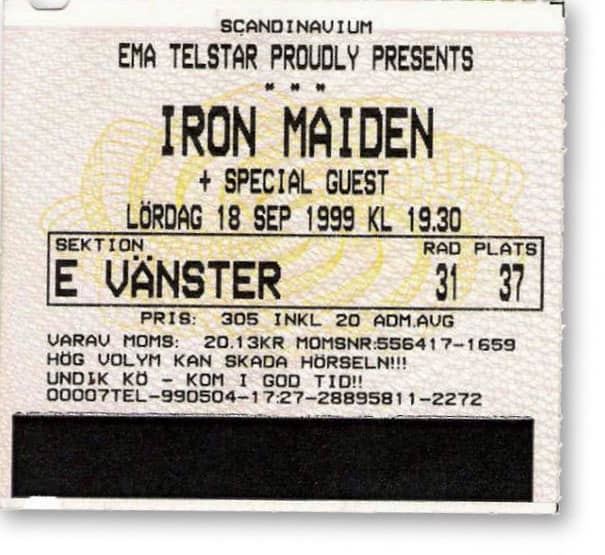
Notes: According to the July 24, 1998, Dynamite Metal News, the band cancelled a string of dates to a throat malady Blaze was suffering: July 19 in San Francisco, California; July 22 in Denver, Colorado; July 24 in Minneapolis, Minnesota; July 25 in Milwaukee, Wisconsin; July 26 in Cincinnati, Ohio; July 28 in Washington, D.C.; July 29 in Baltimore, Maryland; July 31 in Philadelphia, Pennsylvania; August 1 in Hartford, Connecticut; August 2 in Asbury Park, New Jersey; and August 3 in Atlanta, Georgia. Those last two dates were actually taken up by the makeup dates noted.
The band cancelled a December 10, 1998, date due to diplomatic conflict between Chile and the U.K.
Unverifiable sources have indicated that there were December 3 and 4, 1998, shows in Rio de Janeiro and Campinas, Brazil, respectively.
The July 11, 1999, date in St. John, New Brunswick, marked Dickinson’s and Smith’s returns to the Maiden fold.
Dave Murray’s broken finger caused the cancellation of three 1999 U.S. dates: July 31 in San Jose, California; August 2 in Las Vegas, Nevada; and August 3 in Phoenix, Arizona.
